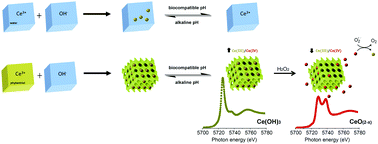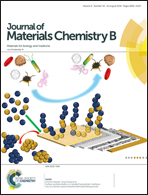Artificial cerium-based proenzymes confined in lyotropic liquid crystals: synthetic strategy and on-demand activation†
Abstract
Inorganic nanoparticles that mimic the activity of enzymes are promising systems for biomedical applications. However, they cannot distinguish between healthy and damaged tissues, which could cause undesired effects. Natural enzymes avoid this drawback via activation triggered by specific biochemical events in the body. Inspired by this strategy, we proposed an artificial cerium-based proenzyme system that could be activated to a superoxide dismutase-like form using H2O2 as the trigger. To achieve this goal, an innovative and easy strategy to synthesize Ce(OH)3 nanoparticles as artificial proenzymes was developed using a lyotropic liquid crystal composed of phytantriol, which was essential to maintain their stability at physiological pH. The transmission electron microscopy measurements showed that the Ce(OH)3 nanoparticles were as small as 2 nm. The nanoparticles were fitted into the tiny aqueous channels of the liquid crystal matrix, which presented a Pn3m space group. X-ray absorption near edge structure measurements were used to determine the Ce(III) fraction of the proenzyme-like nanoparticles, which was around 85%. The Ce(III) fraction dramatically dropped to around 5% after contact with H2O2 because of the conversion of Ce(OH)3 to CeO(2−x) nanoparticles. The CeO(2−x) nanoparticles showed superoxide dismutase-like activity in contrast to the inactive Ce(OH)3 form. The proof of concept presented in this work opens up new possibilities for using nanoparticles as artificial proenzymes that are activated by a biochemical trigger in vivo.

- This article is part of the themed collection: Materials and Nano Research in Brazil


 Please wait while we load your content...
Please wait while we load your content...